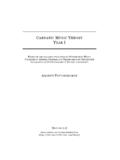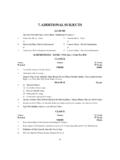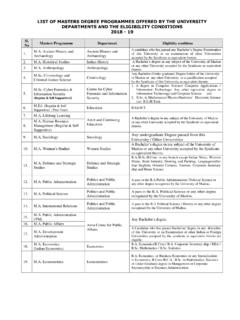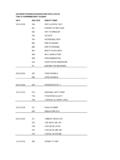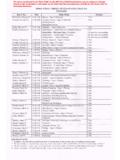Transcription of CARNATIC MUSIC THEORY YEAR I - BeautifulNote
1 C ARNATIC M USIC T HEORY. Y EAR I. B ASED ON THE SYLLABUS FOLLOWED BY G OVERNMENT M USIC. C OLLEGES IN A NDHRA P RADESH AND T ELANGANA FOR C ERTIFICATE. E XAMS HELD BY P OTTI S RIRAMULU T ELUGU U NIVERSITY. A NANTH PATTABIRAMAN. E DITION : Latest edition can be downloaded from Preface This text covers topics on CARNATIC MUSIC required to clear the first year exams in Government MUSIC colleges in Andhra Pradesh and Telangana. Also, this is the first of four modules of THEORY as per Certificate in MUSIC ( CARNATIC ) examinations conducted by Potti Sriramulu Telugu University. So, if you are a MUSIC student from one of the above mentioned colleges, or preparing to appear for the university exam as a private candidate, you'll find this useful.
2 Though attempts are made to keep this text up-to-date with changes in the syllabus, students are strongly advised to consult the college or univer- sity and make sure all necessary topics are covered. This might also serve as an easy-to-follow introduction to CARNATIC MUSIC for those who are generally interested in the system but not appearing for any particular examination. I'm grateful to my late guru, veteran violinist, Vidwan. Peri Srirama- murthy, for his guidance in preparing this document. Ananth Pattabiraman Editions First edition of this text was published in 2009. Editions 2 in 2017. About the author Ananth Pattabiraman is a musician. At Kuyil, a startup he co-founded, he makes mobile apps for CARNATIC MUSIC .
3 CARNATIC apps can be found at Technical Terms Sangeetham is an Indian term for MUSIC . A group of musical sounds, which are called swaras that give melody and pleasant feelings to the ears, is called Sangeetham. Ancient writers hold the view that vocal MUSIC , instrumental MUSIC and dance together constituted sangeetham. Later, dance was separated from the first two. Shruti is an audible sound which can be heard distinctly. It is a musical sound which a well trained human ear is capable of distinguishing. It is the Key note or Adhara Shadjam, based on which all other Swaras are derived. Swara is a musical note which is pleasing to the ears. There are seven basic swaras, known as Saptha Swaras.
4 They are - 1. Shadjam (shortly - Sa). 2. Rishabham (Ri). 3. Ghandaram (Ga). 4. Madhyamam (Ma). 5. Panchamam (Pa). 6. Dhaivatham (Dha). 7. Nishadham (Ni). Arohana Series of Swaras in the ascending order of pitch. Avarohana Series of swaras in the descending order of pitch. Moorchana Arohana and Avarohana together, is called Moorchana Dwadasa Swarasthanas Out of the seven swaras, Shadjam (Sa) and Panchamam (Pa) are constant. They are called Achala Swaras. The remaining five swaras (Ri, Ga, Ma, Dha, Ni) admit varieties and they are called Chala Swaras. In combination, both Achala and Chala swaras yield 12 different musical notes and they are called Dwadhasa Swarasthanas.
5 1. The Dwadasa Swarasthanas are - 1. Shadjam 2. Suddha Rishabam 3. Chatusruthi Rishabam 4. Sadharana Gandharam 5. Anthara Ghandaram 6. Suddha Madhyamam 7. Prathi Madhyamam 8. Panchamam 9. Suddha Dhaivatham Dhaivatham Nishadham Nishadham Sthayi A series of swaras, beginning with Sa and ending with Ni, is called Sthayi. (Equivalent Western term: Octave). There are Five Sthayis: 1. Anumandra Sthayi 2. Mandra Sthayi 3. Madhya Sthayi 4. Tara Sthayi 5. Ati-Tara Sthayi 2. The Sthayi in which we normally sing is the Madhya sthayi. The swaras higher than Nishadam of madhya shtayi form Tara Sthayi. So, swaras in Tara sthayi sound higher in pitch than the same swaras in Madhya sthayi.
6 Immediately below Madhya sthayi Sa are Mandra sthayi swarams, they sound lower in pitch compared to madhya sthayi swarams. Swarams in Mandra, Madhya and Tara stayis form the normal range of human voice. Swarams that are lower than mandra stayi shadjam (Anumandra Sthayi), and higher than Tara sthayi nishadam (Ati-Tara Sthayi) are sometimes used in instrumental MUSIC . While notating, Tara sthayi swaras are written with a dot above them, and Ati-tara sthayi swarams with two dots above them. To indicate Mandra sthayi, a dot below the swaram is added. For Anumandra sthayi, two dots below each swaram are added. Purvanga The group of first four swaras of the Saptha Swaras Sa, Ri, Ga, Ma is known as the Purvanga.
7 Uttharanga The group of last three notes Pa Dha Ni is known as Uttharanga. 3. Dhathu The swara part of the musical composition is known as Dhathu. Mathu The sahitya part of a musical composition is known as Mathu. Akshara Kala Unit time in MUSIC is called Akshara Kala. Thrikaala Kala is refers to the speed of the musical piece. There are Three Kalas, 1. Prathama Kala First degree of speed. One note is sung in one Akshara Kala. 2. Dwitiya Kala Second degree of speed, twice faster than Prathama kala. Two notes are sung in one Akshara Kala. 3. Tritiya Kala Third degree of speed, twice faster than Dwitiya Kala. Four notes are sung in one Akshara Kala. Thourya Trikam - Vocal MUSIC , Instrumental MUSIC and Dance, all the three combined together is referred to as Thouryathrikam.
8 Tala Musical time or measure. Avartha It is the completion of a tala angas or time measure. Angas, Shadangas In order to facilitate easy and accurate method of reckoning musical time, six angas have been devised. They are known as Shadangas or six angas. They are Name of the Sign Number of Aksharas Anga 1. Laghu I 3/4/5/7/9. 2. Drutham O 2. 3. Anudrutam U 1. 4. Guru 8 8. 5. Plutam | 12. 8. 6. Kakapadam + 16. 4. Of the Thalangas, only 3 are widely in use. They are called Principle Thalangas. Here is the list of Principle Thalangas along with their way of counting: 1. Anudrutam (U) One Beat of the Palm on the lap 2. Drutam (O) One beat + One wave (usi/visarjitam).
9 3. Laghu (I) One beat + Count of the fingers Jaati Of the Shadangas, only laghu has variations in number of kriyas. It is called Laghu Jaati bedha. There are 5 Jaatis: 1. Trisra Jaati - 3 Kriyas 2. Chaturasra Jaati - 4 Kriyas 3. Kanda Jaati - 5 Kriyas 4. Misra Jaati - 7 Kriyas 5. Sankeerna Jaati - 9 Kriyas Sapta Talas There are seven principle Talas, they are called Sapta Talas. They are - Name of the Tala Sign Akshara Kala 1. Dhruva Tala IOII 14. 2. Matya Tala IOI 10. 3. Rupaka Tala OI 6. 4. Jampa Tala I7UO 10. 5. Triputa Tala I3OO 7. 6. Ata Tala I5I5OO 14. 7. Eka Tala I 4. 5. The System of 35 Talas There are Seven basic Talas. All these Seven talas are made of Three basic Angas 1.
10 Laghu I. 2. Drutham O. 3. Anu-Drutham U. Here's the Sapta Talas with their symbol denoting their respective angas 1. Druva Talam IOII. 2. Matya Talam IOI. 3. Rupaka Talam OI. 4. Jampa Talam IUO. 5. Triputa Talam IOO. 6. Ata Talam IIOO. 7. Eka Talam I. Among the three angas, Drutham and Anu-Drutham are fixed. They have fixed number of Aksharas (Drutham 2 Aksharas, Anu-Drutham 1. Aksharam). However, Laghu varies in the number of aksharas depending upon it's Jaati. There are 5 Jaathis of Laghu with their corresponding akshara kalas: 1. Trisra Jaati Laghu - 3 aksharas (Symbol) I3. 2. Chaturasra Jaati Laghu - 4 aksharas I4. 3. Kanda Jaati Laghu - 5 aksharas I5.

